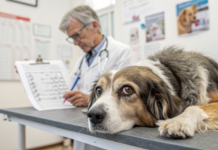Last Updated on September 27, 2022 by Dogs Vets
Can Dogs Get High? And What Can You Do If Your Dog Is Stoned?
As cannabis becomes more legalized, more and more people are wondering if their dog has tried marijuana.
Unfortunately, the answer to this question is a little bit complicated – as marijuana can be found in many different forms, some of which are not safe for dogs to consume.
That’s why it’s important to know what to do if your dog gets stoned – and how to prevent it from happening in the first place.
In this blog post, we’ll explore the topic of dogs and marijuana in detail, and provide tips on how to get your dog unstoned should the occasion arise.
We will be discussing the topic of dogs and weed, as well as how to take care of your dog if they are high.
We will also be answering the question of whether weed can kill a dog, as well as providing tips on how to deal with a marijuana-affected dog.
Finally, we’ll provide a final word on the matter, so that you can make informed decisions about whether or not cannabis is safe for your dog.
Can dogs get high?
Can dogs get high? Yes, they can and depending on the drug, they might experience different effects.
For example, marijuana- marijuana binds to receptors in the brain, causing reacts such as decreased coordination and impaired balance.
As a result, dogs can get high just like humans and should be treated the same way if they display signs of marijuana ingestion, such as vomiting, diarrhea, and abnormal behavior.
If you see any of these signs in your dog, take them to the vet for a check-up as soon as possible!

What to do if your dog is high
Dogs are amazing companions and they love spending time with their families.
However, like humans, some of them can get high and experience changes in their behavior and health.
If you’re worried that your dog has taken drugs, the first step is to assess their condition.
If they appear to be under the influence of something, take them to a veterinarian as soon as possible.
In most cases, dogs will recover from drug use relatively quickly – but it’s always best to err on the side of caution. If you’re really worried that your dog may have taken drugs and is in danger, the best thing to do is to call for help.
My Dog Ate Weed, Is That Bad?
Everyone knows dogs can be cute, cuddly and energetic – but did you know they can also get high? If you’re concerned your dog may have eaten weed, don’t panic.
There are a few things you can do to determine the truth, and if the test results show traces of marijuana, take action accordingly.
First of all, if you’re not sure whether or not your dog has eaten weed, there are a few ways to test for marijuana in their system.
You can try a urine test or a blood test. If you’re worried about your dog’s health, more information about how cannabis affects dogs is available online.
It’s also important to remember that dogs can get high just like humans – and it’s possible for them to eat weed while under the influence.
If the test results show traces of weed, take your dog to the veterinarian for an evaluation. Depending on your dog’s age, weight, and health condition, he or she may require medication or a vet visit
Tips to Stay Calm
When something unexpected and worrying happens, it’s natural to panic. However, there are a few tips that can help keep you calm in difficult situations.
For example, if your dog has eaten weed – don’t freak out! It is most likely not going to cause any serious harm and will soon pass.
It is also important to stay rational when faced with an unpredictable situation; by doing this, you’ll be better prepared for whatever comes next.
Last but not least, remember that even the best-prepared person sometimes fumbles during high-stress moments – so just relax and go with the flow!
What Happens If Your Dog Eats Weed? Symptoms to Look Out For
Dogs and marijuana go together like peanut butter and jelly. But just because dogs are playful and love to play doesn’t mean they should be eating weed.
In fact, if your dog eats weed, they may experience some side effects. These effects can vary depending on the dog, but can generally include changes in heart rate, blood pressure, and even seizures.
If you think your dog has eaten weed, it’s important to take them to the vet for a check-up.
In the meantime, you can try keeping marijuana out of their reach and preventing them from eating it in the first place. Be sure to keep an eye out for any changes in behavior or health, and always consult a veterinarian if you have any questions.
How to Help a Stoned Dog
A marijuana high is a fun experience for humans, but it can be a nightmare for dogs. Even if they’re not actually smoking marijuana, getting a dog high on pot can be a risky proposition.
To minimize the risk of your pup getting high, follow these tips:
Keep pot out of their reach and off the ground – hidden inside toy boxes or cabinets is best ensure that your pet doesn’t accidentally ingest it Remove all potential sources of THC before you let them smoke (it’s best not to smoke while they’re around either).
If you do see your dog high on pot, try to get them away from anything they may have come in contact with – even if it’s something as simple as soil!
Handling a stoned dog can result in additional complications, so keep calm and call for help if necessary! If you see any kind of behavior change, like being hyperactive or destructive, be sure to bring them in for a check-up.
Can Dogs Die from Weed?
Marijuana is still a controlled substance in many states, so it’s important to be aware of the legal implications of bringing it into public view. That said, marijuana can still be dangerous for dogs. Yes, even dogs can die from weed – just like people can.
If you think your dog has overdosed on weed, call the police or emergency services immediately!
In addition to marijuana, other drugs that can be harmful to dogs include cocaine, PCP, and methamphetamines.
Be sure to keep your dog safe by keeping weed out of their reach, and by monitoring their behavior if you think they may have been using any of these drugs.
How to get dog unstoned
So you’ve picked up a pup and you’re just waiting for them to get high so you can spank them.
Hang on, before you go that far it’s important to know that all animals can get high. And yes, dogs can partake in the cannabis high just like humans.
After getting your dog, make sure to keep an eye on them during their first few days home.
If you notice them behaving oddly or if there are signs of marijuana consumption, be prepared to take action. There are a few things you can do in advance to reduce the chances of pot consumption.
For example, keep litter around so your pup can go outside in case they need to do their business. And lastly, make sure you have some good dog-proofing measures in place – like a lock on the door – to keep your pup safe while they’re high.
How to Prevent the Problem
Dogs and marijuana aren’t a great mix. In fact, marijuana is a psychoactive drug that can be addictive for both humans and dogs.
Marijuana is also toxic to dogs, so if problems do arise, it’s important to take steps to get your dog help.
There are a number of options available, including drug intervention programs or attending animal shelter rehoming events specifically for strays with addictions to marijuana.
If you’re uncertain if your dog has ingested marijuana, stop giving it access to the pot and call your vet. There are ways to prevent your dog from getting high – including training them not to chew on pot leaves or smoke it out of an pipe or cigarrette.
As long as you’re proactive and aware of the dangers of marijuana, you’re in good shape.
Visit the Vet
It’s no secret that marijuana is becoming more and more popular, and as such, there has been an increase in marijuana-related cases.
While marijuana is typically safe for humans, it can be harmful for dogs – especially if they’ve ingested it in any form. These can include lethargy, vomiting, diarrhea, difficulty breathing, and seizures.
If you’re unsure if your pet has had contact with marijuana or not – visit a vet for an accurate diagnosis. If they have THC (the psychoactive compound in marijuana) in their system, your dog may experience some serious side effects.
If you believe your dog has smoked marijuana, err on the side of caution and take them to the veterinarian. In the worst case scenario, your dog could be in serious danger and require immediate veterinary care.
Don’t Be Afraid of a Vet Visit.
It’s no secret that dogs love to sniff around, and sometimes this can lead to them getting high. However, there is not always a correlation between sniffing objects and getting high. In fact, some dogs may get high from sniffing leaves or flowers.
If you’re worried that your dog has ingested something that could make them high, don’t be afraid to take them to the vet for a check-up.
Be proactive and keep an eye out for warning signs so you can handle any situation quickly and calmly.
If you’re unsure of what could make your dog high, there are many things in nature that can do the trick. For example, cannabis can make dogs high, so it’s best not to worry until there’s proof of an overdose.
How to Take Care of Your ‘Stoned’ Dog
Dogs have been man’s best friend for centuries, and for a good reason. They’re loyal, loving, and always up for a good time. That being said, there are times when dogs can get high – usually when they’re consuming cannabis.
In cases like this, it’s important to know how to take care of your dog.
If you believe your dog has been high, the first step is to get them checked out by a vet.
If the vet determines that your dog has been stoned, there are a few things you need to remember.
First of all, marijuana is psychoactive, so it can have some pretty serious effects on your dog. Secondly, pot-smoking pets aren’t just for humans any more!
In fact, there’s a growing trend of canine cannabis consumption, so it’s important to be aware of the dangers and take steps to prevent them.
Some tips on how to take care of a ‘stoned’ dog include providing plenty of food and water.
The Final Word
You may be wondering if your dog can get high just like people. The answer is yes, dogs can get high just like us. And, like us, they can end up doing some pretty crazy things when high.
If you think your dog has been smoking pot, there are a few things you can do to take care of them. First, be aware of the signs that your pet may be stoned.
These signs may include changes in behavior, uncharacteristic energy levels, and an inability to focus. If you notice any of these signs in your dog, it’s best to take them to the vet to get a proper diagnosis and treatment.
If you find evidence that your dog has smoked pot, don’t hesitate to take action.
Pot smoking can lead to marijuana poisoning, which can be deadly if not treated quickly.
So be careful what you let your dog smoke, and make sure you know how to get them help if they need it.
Frequently Asked Questions
What should I do if my dog has an overdose of marijuana?
If you think your dog may have ingested marijuana, the first step is to call a veterinarian. Signs that your dog has ingested marijuana include abnormal behavior, difficulty walking or coordination, dilated pupils and vomiting.
You should then take your dog to the vet as soon as possible where they will perform an exam and likely give them a dose of activated charcoal to help with the absorption of THC.
Can dogs eat marijuana edibles safely?
There is no universal answer to this question as it depends on the dog’s weight, size, and other health factors.
However, generally speaking, marijuana edibles are not safe for dogs to eat.
Some dogs may experience vomiting, diarrhea, tremors or hyperactivity when consuming marijuana edibles.
If you’re worried about your dog getting high from eating marijuana edibles, it’s best to keep them away from this type of food altogether.
Can pets get high from residual cannabis smoke?
Pets can definitely get high from residual cannabis smoke and experience a wide range of side effects.
In extreme cases, pets may suffer from serious neurological symptoms like seizures and coma. Pets may become uncontrollably aggressive or nervous, lose appetite or weight, startle easily, and have trouble walking or standing.
Dogs can indeed get high from residual cannabis smoke and experience a wide range of side effects, depending on their exposure levels.
Conclusion
As you can see, there is a lot of information packed into this blog post.
So, make sure to read through all of the content before making any decisions about your pet’s health!
Facts Check
We hope you enjoyed this article… What are your thoughts?
Please feel free to share this article!

















